JOHN S. ALLEN'S BICYCLE FACILITIES, LAWS AND PROGRAMS PAGES |
||
 |
Top: Home Page Up: Bicycle facilities |
 |
JOHN S. ALLEN'S BICYCLE FACILITIES, LAWS AND PROGRAMS PAGES |
||
 |
Top: Home Page Up: Bicycle facilities |
 |
Bike lanes
|
Bike lane in middle of street in Minneapolis, Minnesota
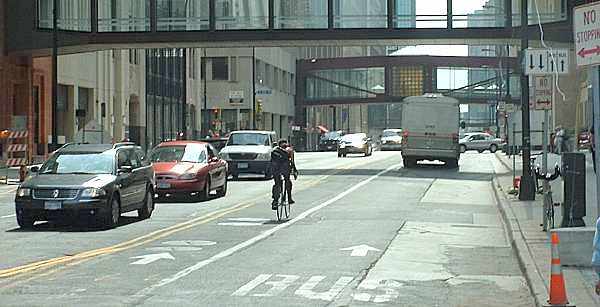
Good examplesAll of the remaining examples on this page will show ways that a bike lane in the middle of the street can avoid rather than create conflicts. University Avenue in Madison, Wisconsin has a bike lane to the left of a bus lane/right turn lane. The Madison installation looks very much like the one in Minneapolis but functions very differently. In Madison, traffic in the bike lane travels in the same direction as in the lanes on both sides of it. Buses do not turn left across the bike lane. The placement of the bike lane avoids having bicyclists and buses "leapfrog" each other, and avoids conflicts between bicyclists and turning vehicles. There is a more detailed description of the Madison installation on another page on this site. |
Bike lane to left of bus lane, Madison, Wisconsin
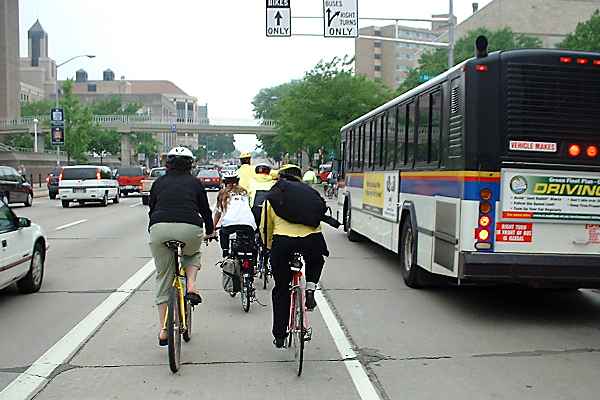
Another good example of a bike lane in the middle of the street is shown below. This is Ravenna Boulevard, in Seattle, Washington, USA, a two-way divided arterial street with a wide median. There is parallel parking along the outside curbs. The bike lane is adjacent to the median. |
Ravenna Boulevard, Seattle, Washington, USA 1987
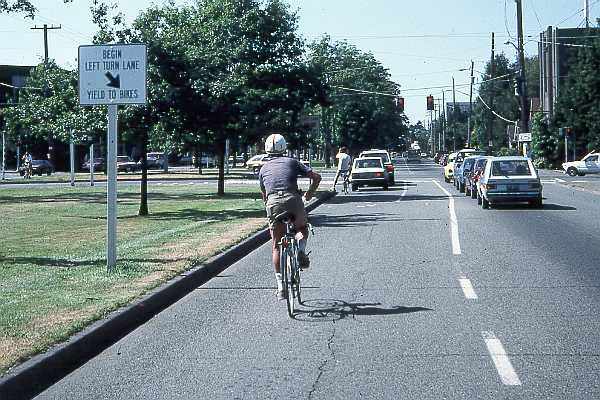
| A disadvantage of the bike lane next to the median is that bicyclists must merge
across the roadway to get to and from destinations at the right side of the street. On the
other hand, the bike lane is not adjacent to parked cars, so car-door collisions are
avoided. The placement of the lane adjacent to a curb allows a more efficient use of
roadway space. Generally, this lane works like any ordinary bike lane adjacent to same-direction traffic. The wide-open median to the left of the lane allows a clear view of cross traffic. The left-turn pocket at the end of the block directs motorists, correctly, to merge to the edge of the roadway before turning. In a parking lot -- a proposalThe following photo is altered to show the author's proposal to improve conditions in a parking lot which was constructed along an old railroad alignment. The only safe place for bicyclists to ride here is in the middle of the lane between parked cars. If they ride too close to the parked cars, a driver exiting a parking space would be unable to see a bicyclist early enough to avoid a collision. Speeds of motor vehicles here are no faster than those of bicyclists. As described on another Web page, the present situation in this parking lot is rather alarming, with bicycle traffic directed head-on into motor traffic. |
Altered photo of parking lot/bikeway, Woods Hole, Massachusetts
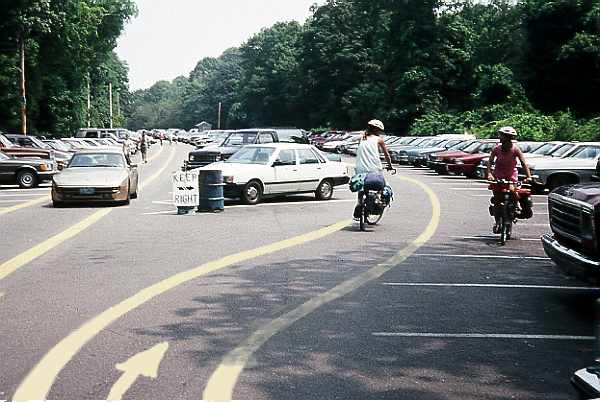
Where bicyclists or motorists must turnWe have seen examples accommodating through travel by bicyclists as well as motorists. Now, let's look at some examples of lanes where either the bicyclists or the motorists must turn. At the T intersection shown below, in Madison, Wisconsin, a bike lane ends before the intersection. Motorists and bicyclists share the right lane when turning right, or merge to a left-turn lane. Bicyclists may keep to the right in the wide, shared left-turn lane, reducing potential conflicts with opposite-direction traffic. |
T intersection in Madison, Wisconsin
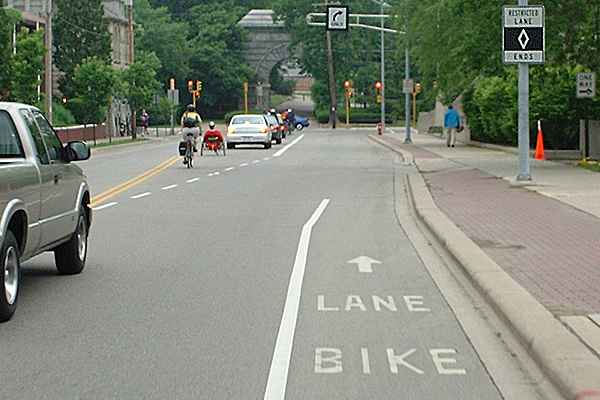
| The next example, from the Village Homes section of Davis, California, is similar except that there is a designated bike lane for left turns. |
John Ciccarelli |
| In the following example from a St. Louis, Missouri suburb, the bike lane to the left of a right-turn lane is for through travel at a four-way intersection, avoiding a conflict with turning traffic. The configuration shown is a standard one described in the AASHTO Guide for the Development of Bicycle Facilities. One unfortunate characteristic here is the concrete gutter pan -- common in Midwestern states -- which puts a seam in the path of right-turning bicyclists. |
Bicycle through lane in suburb of St. Louis, Missouri, USA
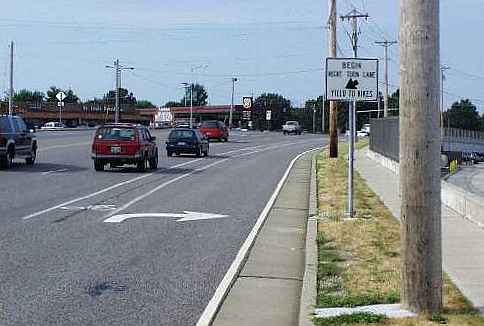
| At the Y intersection shown below, in Palo Alto, California, bicyclists may bear left. The use of curbed median strips is conventional, though it poses some risk of diversion-type falls for bicyclists. The narrow bike lane slot enforces the prohibition against motorists' bearing left. |
Y intersection with bicyclist-only left turn, Palo Alto, California
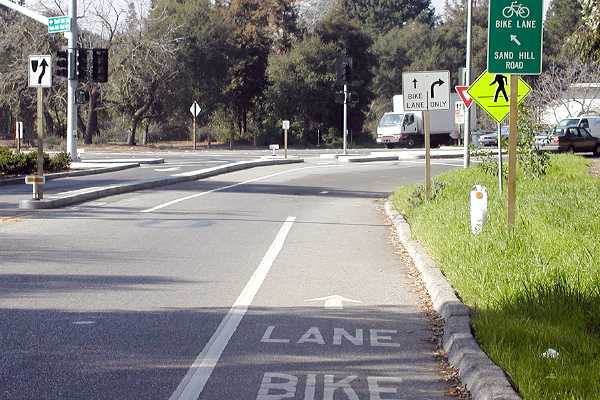 John Ciccarelli |
| The four-way intersection shown below is on a "bicycle boulevard" in an urban area of Palo Alto. There is motor-vehicle access to all points along the street which runs from front to rear in the photo, but the volume of motor-vehicle traffic is kept down by preventing use of the street for through travel by motor vehicles. There is a bicycle-sensitive quadrupole signal actuator in the bike lane. The curbed islands are only long enough to channelize the traffic at the intersection. They are kept out of the area in the foreground where bicyclists must merge left into the through bike lane Emergency vehicles can still get through. |
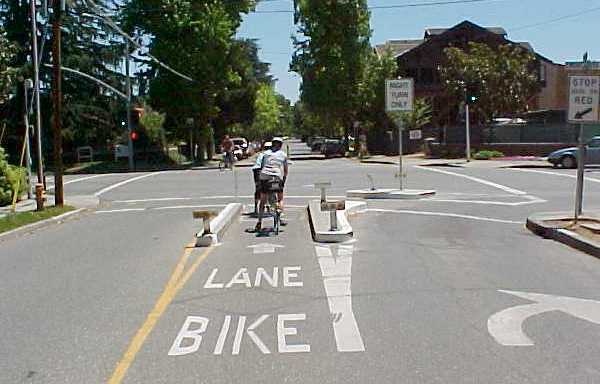 John Ciccarelli |
| The "toucan" crossing shown in the photo below uses an island to the right of the bike lane both before and after the intersection. This installation allows bicyclists to cross an arterial where motorists only can turn right, and also serves pedestrians. In a sense, , the crossing of the arterial is like the crosswalk where a mixed-use trail crosses a road -- but without the trail. |
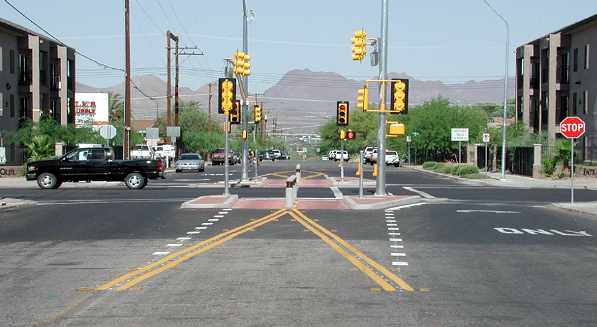 Shellie Ginn, City of Tucson, Arizona |
| What is common to the better installations is that bicyclists and motorists merge to the correct positions for their destinations before the intersection. In none of these installations are bicyclists and motorists required to cross paths inside the intersection. |
| Top: Home Page Up: Bicycle facilities |
Contents © 2004, John S. Allen |